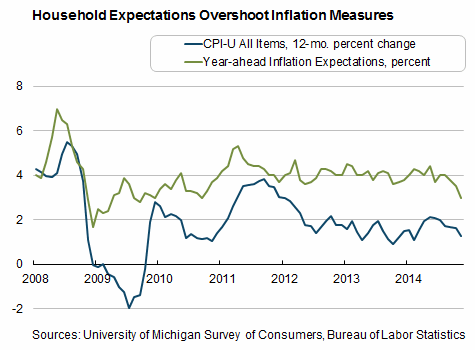Inflation expectations matter. Just ask any central banker (such as the Federal Reserve, the European Central Bank, the Bank of England, or the Bank of Japan).
Central bankers measure inflation expectations in more than a few ways, which is another way of saying no measure of inflation expectations is entirely persuasive.
Survey data on inflation expectations are especially hard to interpret. Surveys of professional economists, such as the Federal Reserve Bank of Philadelphia's Survey of Professional Forecasters, reveal inflation expectations that, over time, track fairly close to the trend in the officially reported inflation data. But the inflation predictions by professional forecasters are extraordinarily similar and call into question whether they represent the broader population.
The inflation surveys of households, however, reveal a remarkably wide range of opinion on future inflation compared to those of professional forecasters. Really, really wide. For example, in any particular month, 13 percent of the University of Michigan's survey of households predicts year-ahead inflation to be more than 10 percent, an annual inflation rate not seen since October 1981. Even in the aggregate, the inflation predictions of households persistently track much higher than the officially reported inflation data (see the chart). These and other curious patterns in the household survey data call into question whether these data really represent the inflation predictions on which households act.
Even if you're unfamiliar with the literature on this subject, the above observations may not strike you as particularly hard to believe. Economists are, presumably, expert on inflation, while households experience inflation from their own unique—some would suggest even uninformed—perspectives.
We have yet another survey of inflation expectations, one from the perspective of businesses leaders. We think this may be an especially useful perspective on future inflation since business leaders, after all, are the price setters. Our survey has been in the field for a little more than three years now—just long enough, we think, to step back and take stock of what business inflation expectations look like, especially in comparison to the other survey data.
Our initial impressions are reported in a recent Atlanta Fed working paper, and the next few macroblog posts will share some of our favorite observations from this research.
We have been asking firms to assign probabilities to possible changes in their unit costs over the year ahead. From these probabilities, we compute how much firms think their costs are going to change in the coming year and how certain they are of that change (see the table). What we find is that the inflation expectations of firms, on average, look something like the inflation predictions of professional forecasters, but not so much like the predictions of households.
But we also find that there is a significant range of opinion among firms, more so than the range of opinions that forecasting professionals express. Some of the variation among firms appears to be related to their particular industries and are broadly correlated with the uneven cost pressures shown in similar industrial breakdowns of the Producer Price Index from the U.S. Bureau of Labor Statistics (see the table).
So what we have now are three surveys of inflation expectations, each yielding very different inflation predictions. What accounts for the variation we see across the surveys? Our survey allows us to experiment a bit, which was one of the motivations for conducting it. We didn't just want to measure the inflation expectations of firms; we wanted to learn about those expectations. In the next few macroblog posts, we'll tell you a few of the things we've learned. And we think some of our initial findings will surprise you.




 By
By 
 Nicholas Parker, economic policy specialist, all in the Atlanta Fed's research department
Nicholas Parker, economic policy specialist, all in the Atlanta Fed's research department